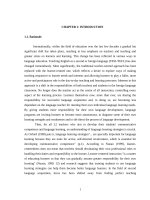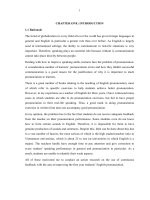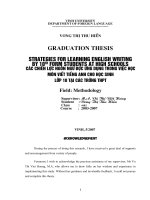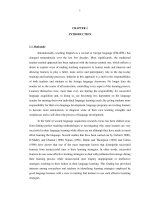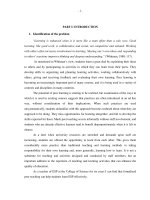Note-taking strategies employed by level 3 students at International School, Vietnam National University, Hanoi while listening to the book Lecture Ready 2 = C.PDF
Bạn đang xem bản rút gọn của tài liệu. Xem và tải ngay bản đầy đủ của tài liệu tại đây (462.05 KB, 14 trang )
VIETNAM NATIONAL UNIVERSITY, HANOI
HANOI UNIVERSITY OF LANGUAGES AND INTERNATIONAL STUDIES
DEPARTMENT OF POST GRADUATE STUDIES
NGUYỄN THỊ THU HUYỀN
NOTE-TAKING STRATEGIES EMPLOYED BY LEVEL 3
STUDENTS AT INTERNATIONAL SCHOOL, VIETNAM
NATIONAL UNIVERSITY, HANOI WHILE LISTENING TO
THE BOOK „LECTURE READY 2‟
(Các thủ thuật ghi chép của sinh viên cấp độ 3 tại khoa quốc tế, đại học
quốc gia Hà Nội khi nghe cuốn “Lecture Ready 2”)
M.A. MINOR PROGRAMME THESIS
Field: English Teaching Methodology
Code: 60 14 10
HANOI - 2011
VIETNAM NATIONAL UNIVERSITY, HANOI
HANOI UNIVERSITY OF LANGUAGES AND INTERNATIONAL STUDIES
DEPARTMENT OF POST GRADUATE STUDIES
NGUYỄN THỊ THU HUYỀN
NOTE-TAKING STRATEGIES EMPLOYED BY LEVEL 3
STUDENTS AT INTERNATIONAL SCHOOL, VIETNAM
NATIONAL UNIVERSITY, HANOI WHILE LISTENING TO
THE BOOK „LECTURE READY 2‟
(Các thủ thuật ghi chép của sinh viên cấp độ 3 tại khoa quốc tế, đại học
quốc gia Hà Nội khi nghe cuốn “Lecture Ready 2”)
M.A. MINOR PROGRAMME THESIS
Field: English Teaching Methodology
Code: 60 14 10
Supervisor: Văn Thị Thanh Bình
HANOI - 2011
iv
TABLE OF CONTENTS
CANDIDATE’S STATEMENT i
ACKNOWLEDGEMENT ii
ABSTRACT iii
TABLE OF CONTENTS iv
LIST OF TABLES vii
LIST OF FIGURES vii
PART : INTRODUCTION 1
I. Rationale of the study 1
II. Scope, objectives, research questions, significance, method and design of the study 2
II.1. Objectives of the study 2
II.2. Research Questions 2
II.3. Scope of the study 2
II.4. Significance of the study 3
II.5. Method of the study 3
II.6. Design of the study 3
PART B: DEVELOPMENT 5
CHAPTER 1: LITERATURE REVIEW 5
1. Overview of listening 5
1.1. Definitions of listening 5
1.2. Types of Listening 6
1.3. Listening techniques 8
2. Notetaking and notetaking strategies 9
2.1. Definitions and importance of notetaking 9
2.1.1. Definition of notetaking 9
2.1.2. Importance of notetaking 10
2.2. Notetaking methods 12
2.2.1. The Cornell Method 12
2.2.2. The Outlining method 13
2.2.3. The Mapping Method 13
2.2.4. The Sentence Method 14
2.2.5. The Charting Method 14
2.2.6. The PARR Method 15
v
2.3. Previous studies on note-taking strategies 16
CHAPTER 2: METHODOLOGY 19
2.1 Research questions 19
2.2. Participants and settings of the study 19
2.2.1. Participants 19
2.2.1. Settings of the study 20
2.3. Data collection instruments 20
2.4. Data collection procedure 21
2.5. Data analysis procedure 22
CHAPTER 3: FINDINGS 23
3.1. Numbers of note-takers and the reasons for not taking notes 23
3.1.1. Number of note-takers 23
3.1.2. Reasons for not taking notes 24
3.2. Students’ personal information and background knowledge of note-taking 25
3.2.1. Student’s personal information 25
3.2.2. Student’s background knowledge of note-taking 26
3.3. Note-taking strategies employed by Level 3 students at International School 28
3.4. Differences in Listening Proficiency, note-taking experience and note-taking knowledge
between note-takers and non-note-takers 30
3.4.1. Differences in Listening proficiency and note-taking experience between note-takers
and non-note-takers 31
3.4.2. Differences in knowledge of note-taking between note-takers and non-note-takers 31
CHAPTER 4: ANALYSIS AND DISCUSSION 33
4.1. Reasons for not taking notes 33
4.2. Note-taking strategies use by Level 3 students at International School 34
4.3. Note- takers vs. non note- takers 35
4.3.1. Differences in listening comprehension and previous experience of note-taking 36
4.3.2. Differences in note-taking knowledge 37
PART C: CONCLUSION 39
1. Summary and Implications 39
2. Limitations and suggestions for further study 40
REFERENCES
APPENDIX
1
Summary of the study
The thesis contains 3 main parts. Part 1 “Introduction” introduces the rationale and the
aims of the study. The scope of the study and the significance as well as the design of the
thesis will also be presented in this chapter.
Listening to an English lecture has long been a difficult task to Vietnamese university
students who hardly had any chances to practice listening skills at lower- level schools. Note-
taking has long been considered an integral part of effective listening. Note-taking while
listening is considered one of the most important skills which language learners should master,
particularly as it helps to develop a sense of listening, allowing the reader to recognize main
ideas and to understand the organization of the material. Note-taking is believed to be an
important part of all of our learning interactions, from the most traditional, structured
experiences to highly informal, unstructured situations.‟ This is extremely significant for
Vietnamese learners who have been studying English listening skills traditionally in non -
native environment, and have just started to learn listening in communicative way.
But acquiring and mastering note-taking is likely to become a big hindrance to many
learners while they often find it difficult to exploit this skill in their learning experience. It is
especially true for General English students at International School, Vietnam National
University, Hanoi, whose English level are not very high. There are many reasons behind this
phenomenon. Students can be neither paying attention, nor write quickly enough. It can be due
to the fact that their spelling is not good enough or they cannot understand the teachers.
Sometimes, the lectures are in a too high level for their capabilities. However, the most
common reason may be students‟ shortage of note-taking strategies to use flexibly in listening
to different lectures.
Therefore, the question of how to equip students with note-taking strategies so that
they can use the skill to support foreign language listening in any situation has become a
matter of teachers of English in general and teachers of English at International School in
particular.
2
In Vietnam, there has so far been some research on note-taking strategies. However,
research on note-taking strategies employed by students at International School, VNU has not
been done yet.
As a teacher of English, I have dealt with many questions relating to note-taking which
are raised by my students or among my colleagues. For example, what are the effective ways
of taking notes? How to note down important information? Personally I found it necessary to
provide to them successful note-taking strategies to listen to the lecture. This is the major
reason why this topic interests me.
The objectives of the study are as follows:
- To indicate whether all the participants take notes while listening to the book „Lecture Ready
2‟, and if not what the reasons are.
- To explore the strategies of note-taking used by Level 3 students at International School.
- To find out whether there are differences in listening proficiency, experience and knowledge
of note-taking between note-takers and non-note-takers or not.
The study is concerned with finding the students‟ note-taking strategies in listening to
the book “Lecture Ready 2”.
As note-taking strategies pointed out by individuals, institutions, and scholars are of a
variety, the present study only focuses on those which are considered to be popular and the
most easily-used by International School students.
This study plays an important role in the identification of note-taking comprehension
strategies employed by Level 3 students at International School. Also, non-note-takers‟
reasons for not taking notes are identified. Based on the findings, the study will have many
important implications for training Level 3 students of English at International School in
taking notes.
3
In order to achieve the aims of the study mentioned above, the descriptive method is
the main tool for analyzing the data, which is collected from the questionnaire.
After the data is analyzed and discussed, the findings will be showed and some
conclusions will be drawn and some suggestions will be raised in the thesis.
The second part is development. This part consists of four chapters. Chapter 1 deals with
a theoretical background. It starts with listening in general including definitions, types and
techniques. “Listening comprehension is not a skill which can be mastered once and for all
and than ignored while other skills are developed. There must be regular practice with
increasingly difficult materials” (Wilga, 1986, p.157). There are many different types of
listening. We can classify these according to a number of variables, including listening
purposes, the role of the listener and the types of text being listened to. However, ther are two
main types: Real-life listening and Classroom listening, the later itself includes two main
types: Intensive listening and Extensive listening.
As for Listening techniques, Southern Nazarene University (1999) introduced effective
listening techniques, which are regarded as top five ways to listen to a lecture. They clarified
their points by making comparison between poor listeners and effective listeners.
The first and foremost technique is to choose to find the subject useful. They explained
that poor listeners dismiss most lectures as dull and irrelevant. Meanwhile, effective listeners
choose to listen to discover new knowledge.
Their second advice is to concentrate on the words and message, not on the professor's
looks, clothes or delivery. In their opinion, poor listeners notice faults in a lecturer's
appearance or delivery, but effective listeners strive to pick every professor's brain for self-
gain.
Thirdly, the University stated that when students hear something they are not sure to
agree with, they should react slowly and thoughtfully. They gave explanation that in such
4
situation, poor listeners stop listening to the speaker and start listening to themselves. They
either passively reject what is being said or launch into impassioned rebuttals (to themselves).
However, in such case, effective listeners do not jump to conclusions and then disengage.
Instead, they keep conclusions tentative while getting more information.
The fourth advice is to identify the "big ideas," those fundamental concepts to which
everything else in the lecture is related. The university pointed out that poor listeners listen
only for facts only. They may retain a few of those facts, but the information is usually
garbled. Whereas, effective listeners look for foundational concepts; they grab key ideas and
use them as anchor points for the entire lecture.
Last but not least, in order to listen effectively, students have to adjust their note taking
system to the lecturer's pattern. According to Southern Nazarene University, some poor
listeners attempt to outline everything, believing an outline and notes are the same thing. They
get frustrated when they cannot see the main points. Meanwhile, effective listeners adjust their
note-taking to the organizational pattern used by the lecturer.
The next issue in this chpater is note-taking and its importance in language teaching,
then an overview of some note-taking methods - their advantages and disadvantages in
applying in the classroom. According to Dunkel (1985), notetaking during the lectures is the
„instinctive, even ritualistic reaction of college students to a lecture presentation‟. It is the
action which “summarizes what said”. Thus, each individual with his own experience and
knowledge can make notes in any way that he likes. From Wikipedia, note taking is defined as
„the practice of recording information captured from a transient source, such as an oral
discussion at a meeting, or a lecture.‟ Castallo (1976) defined notetaking as a "two step
process in which the student must listen for the important information and then write it in
some organized way."
Obviously, note-taking is defined in different words but the main goals of it are
remembering and recording, and note-taking basically is: analytical, organisational and
creative.
5
Notetaking is important because it improves the listening ability by increasing the
listener's attentiveness and prevents sidetracking. Notetaking also increases the listener's
chances of reviewing what he has heard, therefore remedying weaknesses in listening. In
addition, notetaking improves the learner's ability to learn from the spoken word as well as
improves memory of what is heard.
Six methods of taking notes were introduced in this chapter. First, The Cornell Method
is one of the most favorite methods which are widely used in classroom. The Cornell Method
provides a systematic format for condensing and organizing notes without laborious
recopying. After writing the notes in the main space, use the left- hand space to label each idea
and detail with a key word or „cue‟. Second, in The Outlining Method dashed or intended
outlining is used best except some science classes. No numbers, letters, or Roman numerals
are intended in this method.
Note-takers who follow this method have to listen, think, and then write in points in an
organized pattern based on space indentation. They put major points farthest to the left of the
paper; indent each more specific point to the right. Level of importance will be indicated by
distance away from the major points. The relationships between the different parts are come
out through indenting.
Mapping method is the method that maximizes active participation, affords in mediate
knowledge as to its understanding and emphasizes critical thinking.
Note-takers have to use comprehension skills to create note taking form which relates
each fact or idea to every other fact or idea. Mapping is the graphic representation of the
content of a lecture.
This method is of great use when the lecture content is heavy and well- organized.
In the Sentence method, the note-taker writes every new thought, fact or topic on a
separate line, numbering as you make progress.
6
If the lecture format is distinct (such as chronological), note-takers may set up their
paper by drawing columns and labeling appropriate headings in a table-this is Charting
Method. The last method is PARR Method. This method is quite difficult from the four above-
mentioned as it is recently been studied. This method involves four steps: Prepare-
Abbreviation – Revise and Review – students can remember the word PARR as the redolence
of the method‟s name.
The last thing mentioned in the chapter is the previous studies on note-taking strategies
and training.
In chapter two “Methodology‟, an overview of note-taking definition and importance,
methods of note-taking, and a theoretical framework for the investigation were presented.
This chapter will present the issues of methodology used in this study. It begins with the research
questions. It then describes the participants and settings of the study, instruments data collection, and
analytic procedures.
The aim of the present study is to investigate the note-taking strategies employed by level 3
students at International School. The study tried to answer the following questions:
♦ Do Level 3 students at International school take notes while listening to the book
„Lecture Ready 2‟? If not, what are the reasons?
♦ What are note-taking strategies employed by Level 3 students at International
School?
♦ Are there any differences in listening proficiency, experience and knowledge of note-
taking between note-takers and non-note-takers?
A total of 50 students from four Level 3 classes at International School participated in
the study. Twenty eight were female and twenty two were male. The age of the students was
from 18 to 19. They come from different places of the country and their overall English
proficiency was roughly at the level of intermediate
.
The participants have been studying English
7
at International School for 8 months, during this time they have been studying four separated
skills: Listening, Reading, Writing and Speaking. When they were at level 2, “Lecture Ready
1”- the only note-taking oriented book in the syllabus is optional for them. Their note-taking
skills will be tested at the end of level 4.
In order to collect data for the study, survey questionnaire was chosen because it is a
simple and familiar instrument of collecting information from the students and is less time-
consuming than other instruments.
The questionnaire was aimed at measuring the frequency of note-taking strategies
used. It consists of two sections: the first section includes the questions to gain personal
information about the participants and their general knowledge of note-taking; the second
section includes the questions about the strategies that participants may have used when they
listen to the book „Lecture Ready 2‟. It contained 16 items.
Before letting students do the survey questionnaires, the researcher asked the
participants to take quick notes of a lecture in a different book („Real Listening and speaking
3‟ by Mile Craven). Their notes were collected to serve the purpose of the questionnaire
design. Although all the participants took notes, only some of them have good notes in which
Outline Method, Sentence Method and PARR method are used.
The data gathered through the questionnaire were coded for statistical analysis to
investigate which note-taking strategies are used and how popular each strategy is to the level
3 students at International School. The questions in the questionnaire will be analyzed one by
one following their position in the questionnaire section by counting its percentage (Question
1,2,3,4) or number (Question 6,7).
This chapter 3 “Methodology”reports the results from the analysis of 50 students‟ responses
from questionnaires. The results will be presented on four main parts as follow: 3.1. Numbers of note-
8
takers and the reasons for not taking notes, 3.2. Students‟ personal information and note-taking
knowledge, 3.3. Note-taking strategies employed by students, 3.4. Difference in listening proficiency,
experience and knowledge of note-taking between note-taker and non-notetakers
The last chapter in this part is “Analysis and discussion”. Particular emphasis is given
to the discussion of the overall note-taking strategies used by students in this chapter. The
differences in listening proficiency as well as note-taking experience and knowledge between
note-takers and non note-takers are also analyzed and discussed. The reasons for not taking
notes are given discussion and analysis as well.
The third main part of the thesis is “Conclusion”. This part summaries the findings of
the study and give some implication.
The study indicates that there are not only note-takers but also non-note-takers when
participants listen to the book „Lecture Ready 2‟. The number of students who do not take
notes exceeds that of students who perform note-taking. From this finding, it is concluded that
note-taking skill in Listening classroom at International School is not very familiar to Level 3
students at International School.
This study also generated interesting findings about learners‟ reasons for not taking
notes. Among the given reasons, the most common one is not having the habit of taking notes,
and the least common one is „don‟t like taking notes.‟ Based on this finding, it is suggested
that note-taking cannot become a habit of Level 3 students due to their lack of practice. The
easiest way to make up for it is the teacher‟s encouragement for students. As it is not because
students don‟t like taking notes, that teachers encourage students and create opportunity for
note taking to be used in class can better the current situation.
The findings of the study illustrate that all the strategies introduced in the questionnaire
are used by the note-takers. Nevertheless, there is a difference in the frequency of each
strategy used and the number of strategies employed by each student. The most preferred note-
taking strategy is to decide what is important whereas leaving the wide margin when taking
9
notes and using ink not pencil are the strategies in the least frequency of use. Thirteen is the
highest number of strategies used by a participant, but there is one student who can employ
two note-taking strategies only. As most of the given strategies taken from “Lecture Ready 2”
and the others are highly appreciated for Intermediate level, the combination as well as the
flexible application of them in different listening lecture is very important. Therefore, the
more strategies student can use, the better listening results they can achieve.
The findings of the study also supported the researcher‟s assumption that there are
differences in note-takers and non note-takers previous experience and knowledge of note-
taking. In general, the note-taker group has better understanding of note-taking than the non
note-taker one. Furthermore, there are more note-takers were taught to take notes before then
non-note-takers., which imply that if students have been taught to note down, there is a
likelihood that they will do so in the future.
Contrary to what the researcher assumed, the listening proficiency of note-takers and
that of non note-taker group are the same. This is because at level 3, students are not tested to
use note-taking skill in the final examination. Whether or not students know how to take notes
and use note-taking, their listening scores at this level, thus, have no prominent difference. In
spite of that, at level 4, note-taking is a vital skill for students at International School to pass
the IELTS oriented final test. Therefore, it is necessary for the test designer at this level to add
note-taking as a skill to be checked to prepare for Level 4 examinations.
It is important for curriculum writer, test designers, teachers and students alike to
acknowledge that a balanced and integrated approach to note-taking is important particularly
for foreign language learners at International School. Pedagogically, it is important and
feasible that teachers play a more active role in students‟ note-taking practicing by providing
learners with systematic note taking instructions, offering contextualized learning
opportunities, helping students learn specific strategies for taking notes. The ultimate purpose
is to encourage learner autonomy so that students can employ note-taking wisely both inside
and outside of the class for more productive outcomes.
10
This part also points out the Limitations and suggestions for further study
This was an exploratory study that only caught a glimpse of the present status of note-
taking strategies employed by Level 3 International School students. A larger sample with
more diverse backgrounds would be desirable in order to yield more generalizable findings.
Furthermore, the data for the study were based on the self reports of the participants.
Therefore, further studies are needed using other instruments such as oral interview and so on.
Such multiple sources would provide more insights into what learners actually do. Hopefully,
this will lead to more thorough investigations in the field.


